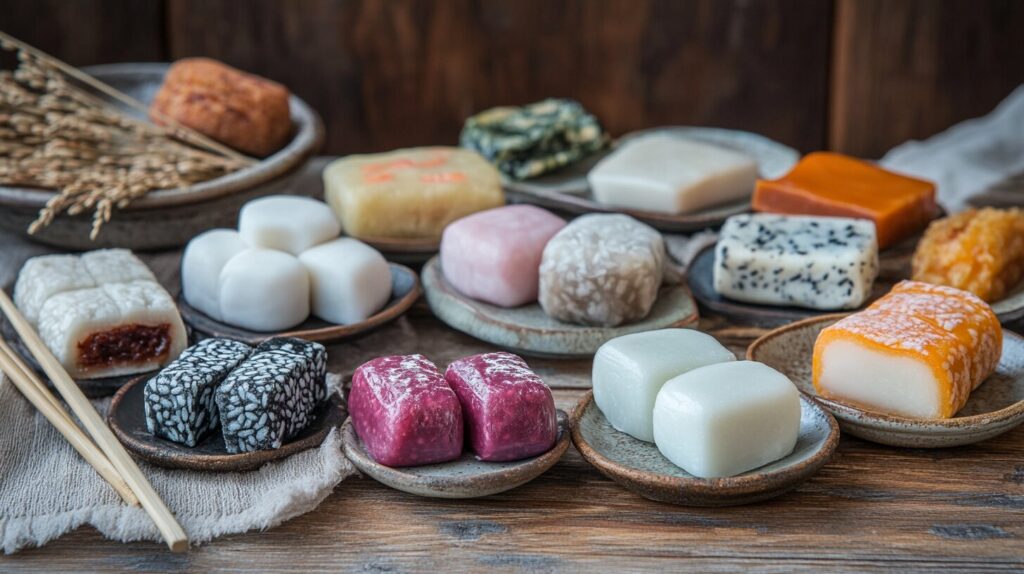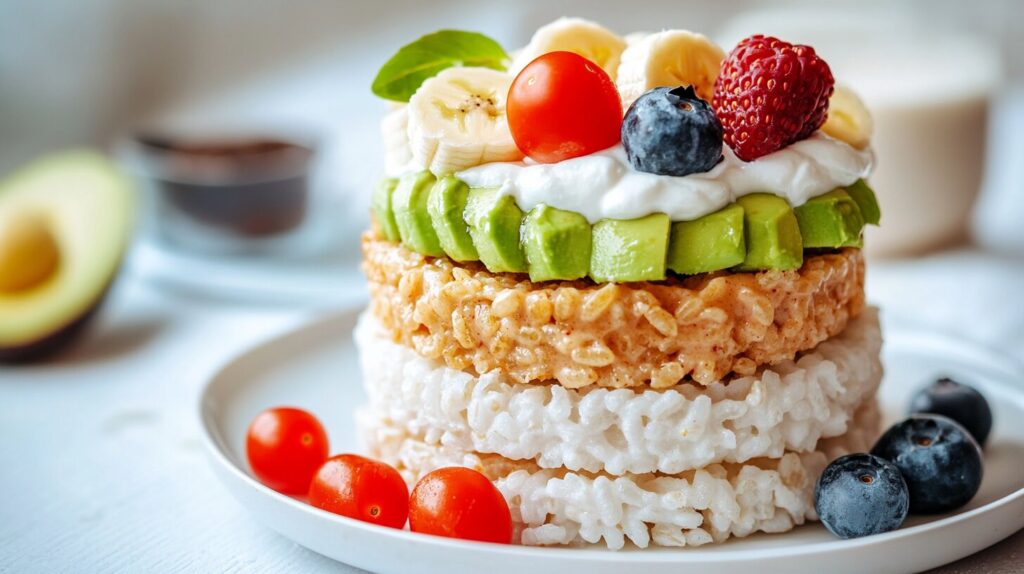People around the world enjoy rice cakes in various forms. In Asian cuisine, they appear as chewy variations in traditional desserts. You can often find them as puffed, crunchy snacks in Western stores These treats are simple and versatile, making it easy to customize them with different toppings and flavors. Because of this adaptability, rice cakes cater to a wide range of tastes and dietary preferences.
Over time, these snacks have evolved to offer both traditional and modern interpretations, making them suitable for various meals and snacks. With the growing trend of health-conscious eating, rice cakes remain popular due to their low-calorie count and gluten-free nature.
Table of contents
Introduction
Rice cakes are easy and flexible snacks made mostly from rice. Manufacturers press and mold the rice into various shapes and often enhance the flavor by adding salt, water, or other seasonings. Depending on cultural tastes, rice cakes can be sweet or savory. They may feature white rice, brown rice, or glutinous rice, sometimes topped with seeds, fruits, or herbs.
Because they are gluten-free and naturally low in fat, rice cakes are popular among those seeking healthier snack options. The preparation method determines their texture, which can range from soft and chewy to crispy and light.
The Origin and History of Rice Cakes

Ancient Beginnings in Asia
Rice cakes have a history stretching back thousands of years to Asia, where rice cultivation flourished. In ancient China, rice was more than just a dietary staple; it also held deep symbolic significance in religious rituals. The Japanese crafted mochi from glutinous rice and enjoyed it during festivals and celebrations. In Korea, tteok became a traditional centerpiece at weddings and harvest festivals.
These ancient recipes have been passed down through generations, preserving cultural traditions and influencing modern rice cake varieties.
Global Spread of Rice Cakes
As trade routes expanded, rice cakes spread beyond Asia to the rest of the world. Travelers and immigrants brought their traditional recipes to new regions, where they were embraced and adapted. In Southeast Asia, countries like the Philippines and Indonesia incorporated versions such as puto and kueh into everyday cuisine.
In the 20th century, puffed rice cakes became popular in Western countries as a low-calorie snack. Over time, different cultures adjusted rice cakes to match local tastes, reflecting a rich tapestry of global culinary traditions.
Cultural Significance of Rice Cakes
Rice cakes hold deep cultural meaning in many societies. In East Asia, they play essential roles in rituals, festivals, and celebrations. In Japan, mochi symbolizes prosperity and good fortune, especially during New Year festivities. Koreans serve tteok at important life events such as weddings, births, and national holidays. In China, people enjoy nian gao during Lunar New Year as a symbol of progress and growth.
Outside of Asia, Western cultures associate rice cakes with health-conscious eating and balanced lifestyles. These snacks cross cultural boundaries while preserving traditional values, highlighting their enduring importance in both heritage and modern life.
Basic Ingredients in Rice Cakes
Primary Ingredient – Rice
Rice forms the foundation of rice cakes, and the type used greatly impacts texture and flavor. White rice creates a light, neutral-tasting snack, while brown rice adds a nutty flavor and extra fiber. Glutinous rice produces chewy, dense treats ideal for traditional recipes like mochi.
Manufacturers prepare rice by steaming, boiling, or puffing it before shaping it into cakes. The quality of the rice and the preparation method play crucial roles in determining the final product’s consistency and taste.
Additional Ingredients and Flavors
Although rice takes center stage, other ingredients enhance both taste and texture. Traditional recipes may include sugar, salt, sesame seeds, red bean paste, or nuts. Savory versions often feature herbs, spices, or soy sauce. Modern products incorporate flavors like cinnamon, chocolate, or caramel to appeal to diverse tastes.
Binding agents such as water or oil help create the right consistency. These additions make rice cakes adaptable for both sweet and savory snacks.
Gluten-Free and Vegan Considerations
Rice cakes naturally fit into a gluten-free diet, making them ideal for those with celiac disease or gluten sensitivities. Since rice does not contain gluten, plain rice cakes are usually safe to eat. However, always check flavored varieties or those with additional ingredients, as some may include gluten-based additives.
Most rice cakes also follow vegan-friendly recipes, containing only rice, water, and salt. With the rise in plant-based diets, these snacks offer a convenient vegan option. To avoid hidden non-vegan ingredients, such as dairy-based seasonings, it’s best to read labels carefully.
The Process of Making Rice Cakes
Traditional Methods of Preparation
Different cultures employ unique traditional methods for making rice cakes. In Japan, for example, preparing mochi involves steaming glutinous rice and then pounding it with a wooden mallet in a mortar until it becomes a sticky, elastic dough. This dough is shaped into small balls or cakes and often filled with sweetened red bean paste.
In Korea, tteok is crafted by steaming rice flour and shaping it into intricate designs for festivals and ceremonies. In Southeast Asia, snacks like puto are steamed in small molds, with banana leaves often used to enhance the flavor. These traditional methods demand skill, patience, and community effort, preserving culinary heritage and adding cultural significance to each creation.
Modern Commercial Manufacturing

Modern manufacturing has streamlined the process for mass production. Manufacturers start by milling rice into a fine flour. They mix the flour with water and sometimes salt to form a dough-like mixture. The mixture is then placed into molds and subjected to high pressure and heat, which causes the rice to expand and puff up quickly.
Machines can produce thousands of uniform rice cakes per hour, ensuring consistent size, texture, and quality. To cater to a variety of tastes, commercial producers often add flavors, seasonings, or coatings, offering both sweet and savory options.
Key Differences in Preparation Techniques
Traditional methods emphasize cultural significance, texture variety, and hands-on techniques like steaming, pounding, or fermenting. These methods often produce chewy or dense rice cakes, tailored to specific dishes or rituals. Creating these treats requires skill, time, and community participation.
In contrast, modern commercial methods prioritize efficiency, consistency, and scalability. This streamlined approach yields light, airy, and crispy textures that suit the needs of convenience and long shelf life. While traditional methods celebrate heritage and craftsmanship, modern techniques focus on accessibility and large-scale distribution.
Types of Rice Used in Rice Cakes
White Rice vs. Brown Rice
White and brown rice are the main types used in rice cakes, each offering different textures and flavors. Manufacturers mill and polish white rice, which removes the bran and germ. This process results in a lighter texture and a milder flavor. In contrast, brown rice retains its bran layer, giving it more fiber, vitamins, and minerals. It also has a nuttier flavor and a denser texture.
People who focus on health often prefer brown rice for its added nutrients. Both types of rice work well with various seasonings and toppings, making them versatile for different recipes.
Sticky Rice vs. Non-Sticky Rice
Sticky rice, or glutinous rice, is best for making chewy rice cakes like mochi in Japan or tteok in Korea. Its high starch content gives it a gluey texture when cooked, helping it hold together and stay elastic. This quality makes it perfect for dense, chewy treats.
On the other hand, non-sticky rice, such as long-grain varieties, is better for puffed or crispy rice cakes. Because it doesn’t clump together, it produces light and airy snacks. The choice between sticky and non-sticky rice depends on the texture you want for the rice cake.
Different Varieties of Rice Cakes
Asian Rice Cakes (Mochi, Tteok, etc.)
Asian rice cakes come in a wide variety, deeply rooted in cultural tradition. In Japan, people make mochi using glutinous rice and often fill it with red bean paste, ice cream, or matcha flavoring. Korean tteok appears in many forms, such as songpyeon—crescent-shaped rice cakes filled with sesame seeds or chestnuts. In China, families enjoy nian gao during Lunar New Year as a symbol of prosperity and growth.
These traditional treats usually have a chewy, dense texture and play important roles in cultural celebrations. Preparation methods differ widely; cooks may steam, boil, fry, or bake them, reflecting centuries of culinary heritage.
Puffed Rice Cakes
Puffed rice cakes are the most common type in Western markets. Manufacturers create these by applying high pressure and heat to rice, causing it to expand or “puff” into a light, crispy cake. These cakes are often round and disc-shaped, making them easy to snack on.
They come in plain or flavored varieties, with toppings like salt, cheese, caramel, or chocolate. Many people enjoy them for their low-calorie content and versatility. Puffed rice cakes can serve as a base for spreads and toppings or as a simple stand-alone snack. Their long shelf life and portability make them a staple in many health-conscious households.
Sweet and Savory Varieties
Rice cakes are available in both sweet and savory options, satisfying a range of tastes. Sweet varieties often feature ingredients like red bean paste, fruits, or a sugar coating. Examples include Japanese mochi and Filipino puto.
Savory versions, on the other hand, might include soy sauce, sesame oil, herbs, or spices. In Korea, tteokbokki is a popular street food where rice cakes are stir-fried in a spicy sauce. Western puffed rice cakes also come in savory flavors like sea salt, cheese, and herbs. This wide variety ensures rice cakes remain adaptable and appealing to diverse palates.
Nutritional Value of Rice Cakes
Calorie Content and Macronutrients
These treats are known for being low in calories, making them popular among those looking to manage their weight. A typical plain puffed rice cake contains around 35-60 calories, depending on size and ingredients. These snacks have low fat content and minimal protein, usually 1 gram or less per serving. Carbohydrates make up the bulk, with 7-14 grams per cake. Fiber content is low unless they are made with brown rice or paired with fiber-rich toppings.
Health Benefits of Rice Cakes
These snacks offer several health benefits when consumed in moderation. They are naturally gluten-free, making them suitable for those with celiac disease or gluten sensitivity. Because they are low in fat and calories, these treats can support weight loss or maintenance goals when paired with healthy toppings. Brown rice cakes offer additional benefits due to their higher fiber content, which aids in digestion and helps maintain blood sugar levels. The simplicity of rice cakes allows them to serve as a neutral base for nutrient-rich toppings like avocado, nut butter, or fruits, making them a versatile and healthy snack option.
Potential Drawbacks and Concerns
Despite their benefits, rice cakes also have some drawbacks. Their high glycemic index (GI) can cause rapid blood sugar spikes, particularly if eaten alone. This can be concerning for people with diabetes or those aiming to manage their blood sugar levels. Many commercial rice cakes lack fiber, protein, and healthy fats, which means they may not keep you full for long. Additionally, flavored rice cakes often contain added sugars, salt, and artificial ingredients, which can reduce their health benefits. To mitigate these concerns, opt for brown rice cakes and pair them with protein- or fiber-rich toppings to balance their nutritional profile.
Popular Ways to Enjoy Rice Cakes

Healthy Toppings and Spreads
These snacks can be transformed into a satisfying treat with the right toppings. For a nutritious option, spread nut butter like almond or peanut butter and add banana slices or a sprinkle of chia seeds. Avocado mash with a pinch of salt, pepper, and lemon juice creates a savory, filling snack. Greek yogurt with berries and a drizzle of honey offers a protein boost and natural sweetness. Hummus with sliced cucumber or cherry tomatoes provides a balanced, fiber-rich topping. These combinations enhance the taste and nutritional value of rice cakes, making them more filling and satisfying.
Recipes and Snack Ideas
These treats can be used in a variety of creative recipes. For a quick breakfast, top a rice cake with scrambled eggs and spinach. For a sweet snack, spread cream cheese and top with sliced strawberries and a drizzle of dark chocolate. Create mini pizzas by adding tomato sauce, mozzarella cheese, and basil, then lightly toasting until the cheese melts. For an energy-boosting snack, layer almond butter, sliced apples, and a sprinkle of cinnamon. These simple recipes allow you to enjoy rice cakes in different ways while adding nutrients and flavor to keep your snacks interesting.
Pairing Rice Cakes with Meals
These cakes can also complement larger meals. Use them as a substitute for bread or crackers alongside soups and salads. Pair these treats with cottage cheese and smoked salmon for a protein-rich meal. Additionally, they work well as a base for open-faced sandwiches, such as turkey, lettuce, and tomato. In Asian cuisine, steamed rice cakes are often served with stir-fried vegetables or stews. The versatility of rice cakes allows them to fit into various meal types, whether as a side, snack, or base for more elaborate dishes. They are an excellent option for adding crunch and lightness to meals.
Are Rice Cakes a Healthy Snack Option?
Low-Calorie Snacking
Rice cakes are often marketed as a low-calorie snack, making them a favorite among dieters. With only 35-60 calories per cake, they can be enjoyed guilt-free. Because of their low calorie count, rice cakes can be part of a balanced diet when paired with nutrient-dense toppings. However, eating them alone may not provide enough energy or satiety. To make the most of rice cakes as a low-calorie snack, add toppings like nut butter, avocado, or cheese to increase their nutritional value. This way, you can enjoy a satisfying snack without significantly increasing your calorie intake.
Comparing Rice Cakes to Other Snacks
Compared to other snacks, rice cakes stand out for their simplicity and low-calorie content. They are a healthier alternative to potato chips, which are high in fat and sodium. When compared to crackers, rice cakes generally have fewer calories and simpler ingredients. However, crackers often contain more fiber and protein, which can help keep you full longer. Compared to granola bars, which may contain added sugars, plain rice cakes have no added sweeteners. Ultimately, the healthiness of rice cakes depends on your dietary needs and how you pair them with other foods to create balanced snacks.
Frequently Asked Questions (FAQs)
Are Rice Cakes Gluten-Free?
Yes, most rice cakes are naturally gluten-free since they are made from rice, which does not contain gluten. However, it’s essential to check the packaging for flavored or coated varieties, as some additives may contain gluten. For people with celiac disease or gluten sensitivity, look for products labeled “certified gluten-free” to ensure there’s no risk of cross-contamination.
How Long Do Rice Cakes Stay Fresh?
Rice cakes generally stay fresh for about 6-12 months if stored properly in a cool, dry place. Once opened, keep them in an airtight container or reseal the package tightly to prevent them from becoming stale. Check the expiration date on the package, as freshness can vary depending on preservatives and manufacturing processes.
Can Diabetics Eat Rice Cakes?
People with diabetes can eat rice cakes, but caution is needed due to their high glycemic index (GI), which can cause blood sugar spikes. To reduce the impact, opt for brown rice cakes and pair them with protein- or fiber-rich toppings like nut butter, avocado, or hummus. This combination helps slow down glucose absorption and maintains stable blood sugar levels.
How Are Rice Cakes Different from Crackers?
Rice cakes and crackers differ in ingredients, texture, and nutritional content. Rice cakes are typically made from puffed rice and have a light, airy texture, while crackers are made from flour and have a denser, crispier texture. Crackers often contain more fiber and protein, while rice cakes are lower in calories and fat. Your choice depends on your dietary preferences and health goals.
Are Rice Cakes a Good Source of Fiber?
Plain rice cakes made from white rice are low in fiber. However, those made from brown rice contain more fiber due to the retained bran layer. To boost fiber intake, choose brown rice cakes and add high-fiber toppings like fruits, vegetables, or seeds. This combination can help support digestion and maintain satiety.
Do Rice Cakes Help with Weight Loss?
Rice cakes can support weight loss because they are low in calories and fat. However, eating them alone may not keep you full for long. To make them more satisfying, pair rice cakes with protein or healthy fats, such as nut butter, cottage cheese, or avocado. This strategy helps you feel full longer and reduces the likelihood of overeating later.
Conclusion
Rice cakes are a versatile and widely enjoyed snack with a rich history and cultural significance. They can be a healthy addition to your diet when chosen wisely and paired with nutrient-dense toppings. While they offer benefits like being low in calories, gluten-free, and easy to customize, it’s essential to be mindful of their high glycemic index and low fiber content. Whether you enjoy them as part of traditional recipes or as a modern snack, rice cakes remain a simple, adaptable food for various tastes and dietary needs.
